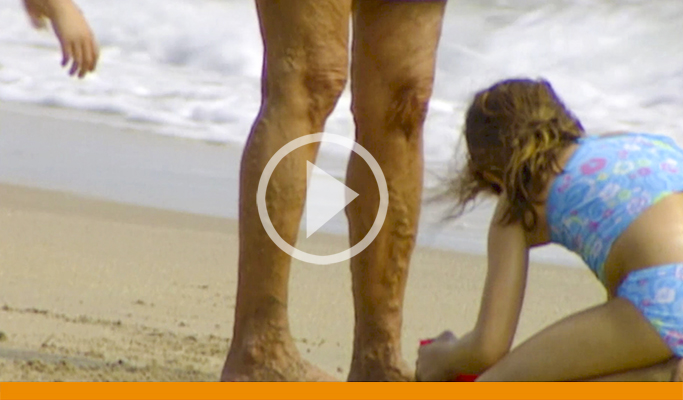Varicose veins
What are varicose veins?
Varicose veins are veins near the surface of the skin, usually in the legs, that have become swollen and can be felt through the skin. These bulging, bluish veins are often found on the inside of the calf or thigh.
An estimated 20 to 25 million people in the United States have varicose veins. They are more common in women than in men.
Veins are the soft-walled vessels that carry blood from the legs back to the heart. Veins contain one-way valves to keep the blood from flowing backwards; but working against gravity can take its toll. Varicose veins result when the vessel walls weaken or the valves fail. Over time and under the pressure of gravity, the veins may become dilated, elongated, twisted, and thickened. Backwards flow of blood due to damaged valves is called reflux.
Varicose veins are larger than thee millimeters in diameter, as opposed to reticular veins that are between one and three millimeters in diameter, or spider veins, which are smaller than one millimeters in diameter. While varicose veins are usually not a serious medical problem, they can be uncomfortable and may lead to inflammation and, more rarely, clot formation.
Symptoms of varicose veins
The most common symptoms of varicose veins include:
- Heavy, burning and/or aching of the legs
- Leg pain that is worsened by prolonged sitting or standing
- Leg swelling
- Rashes
- Color changes in the skin
- Sores on the legs
Untreated large or extensive varicose veins may lead to swelling, skin thickening or non-healing sores.
Risk factors of varicose veins
The risk factors for developing varicose veins include:
- Gender (more likely in women)
- Obesity
- Aging
- Pregnancy
- Leg injury
- Hormones
- Family history
Diagnosis for varicose veins
- Duplex ultrasound: A type of ultrasound for assessing blood-flow and structure of the leg veins.
- Magnetic resonance venography (MRV): A diagnostic procedure that produces detailed, three-dimensional images. Magnetic resonance technology involves the use of magnets, radiofrequencies and computers to produce the images. MRV also includes the use of a contrast dye to help visualize the veins.
Treatment for varicose veins
Treatment of varicose veins may not be necessary if symptoms are not bothersome. If treatment is necessary, the focus will be on the three E's: exercise, elevation and elastic compression.
- Exercise: Exercise helps pump blood through the legs and builds muscle that can promote better circulation.
- Elevation: Elevating the legs can help to instantly relieve pain. A doctor may also instruct a patient to elevate the legs above the heart three or four times a day for about 15 minutes at a time. This can help to reduce swelling. If prolonged standing or sitting is necessary, bending the legs several times will help promote blood circulation.
- Elastic compression: Elastic compression stockings increase in tightness from the toes to the calves. They squeeze the leg veins, exerting additional pressure that helps to prevent blood from flowing backwards.
If the three E's don't substantially relieve bothersome symptoms, varicose veins may also be treated in the following ways:
Sclerotherapy
Sclerotherapy, the most common treatment for varicose and spider veins, is the permanent blocking of the affected veins using an injected solution. The solution causes the vein to scar closed so that blood can no longer flow through it. The vein eventually shrivels and is absorbed by the body. Blood that used to flow through the vein returns to the heart via normal, healthy veins nearby. This is an outpatient procedure with little recovery time involved.
Minimally invasive treatments
- Radiofrequency closure: A catheter is placed in the greater saphenous vein, the largest superficial vein along the medial thigh, and radiofrequency energy heats the vein tissue. The vein is closed and is eventually scarred shut. The abnormal reflux of blood is stopped.
- Endovenous laser therapy: A thin, laser, optical fiber is inserted through a catheter in the greater saphenous vein, the largest superficial vein along the medial thigh. Laser energy is delivered through the tip that heats the diseased portion of the vein. The vein is closed and scarred shut.
- Ambulatory phlebectomy: The varicose veins are removed through tiny incisions in the leg using fine surgical instruments. Stitches are not necessary and recovery is brief. This procedure is often done in conjunction with radiofrequency closure, endovenous laser therapy, or surgical stripping of the greater saphenous vein.
Surgical treatment: Venous stripping
This procedure involves the removal of the greater saphenous vein, the largest superficial vein along the inner thigh. It is removed through a small incision in the groin, and second small incision near the knee.

